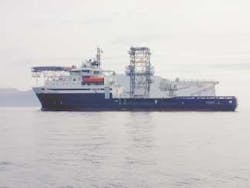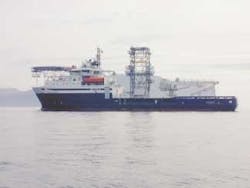New generation UT vessels offer higher power, speed, comfort, enhanced positioning
Nick Terdre
Contributing Editor
Marine activity in Rolls-Royce has expanded in recent years through the acquisition of Vickers, bring-ing with it well-known names such as Ulstein and Kamewa. Rolls-Royce Marine AS (RRM) is now a leading force in supplying the needs of the offshore shipping industry. Its wide-ranging capabilities include ship design, propulsion and control systems, deck machinery, maneuvering systems, and engines.
At the heart of its offshore contribution is the UT700 series of ship designs. These are in action all over the world. In fact, having supplied about 50% of the market in the last few years, UT-Design can lay claim to being the world leader for offshore vessels, according to Nils Peter Pilskog, sales manager, E&P. More than 450 offshore units based on the UT700 designs have been built or ordered.
Originally launched in the 1970s, the designs have been applied to platform supply vessels (PSVs), anchor-handling tugs, towing vessels, standby vessels, test production vessels, seismic acquisition vessels, cable-layers, and well intervention vessels. The designs have proved popular not only for their flexibility but also because of the company's willingness to work closely with shipyards and owners to achieve a delivery tailored to the owner's wishes, Pilskog says.
A series of developments is now under way to meet the changing needs of the offshore industry. The move into deeper waters farther from shore, for example, creates a need for supply vessels with greater cargo capacity and higher speed and for anchor-handlers with more powerful winches and lockers for storing larger quantities of rig chain and other types of mooring.
The trend toward subsea installations has created a need for more versatile construction and maintenance vessels, again capable of deepwater operation, and for enhanced dynamic positioning (DP) capability requiring more powerful and versatile thruster outfits. At the same time, there is increasing recognition of the crew's requirement for an acceptable working environment. This has strengthened the demand for vessels that conform to the "comfort class'' notation. Owners and authorities are exerting pressure for improved environmental performance, including reduced emissions, and improved fuel economy.
In anticipation of emerging needs in arctic areas, the company has developed a range of ice-breaking vessel designs.
Last year saw the delivery of the first subsea well intervention vessel based on UT-Design UT737L. The Island Frontier, built at the Søviknes yard in Brattvåg on the mid Norwegian coast on behalf of Island Offshore 5 K/S. At 107 m, is a long version of the UT737 design and incorporates a 7 m x 7 m moonpool, large enough for module handling, an ROV garage, and tanks for storing the mud and brine required for well intervention.
Other multifunctional designs include the UT527, which has a multi-field standby function including fire fighting, rescue, emergency towing, and oil spill response. The first such vessel, Havila Troll, was delivered in late 2003 and is on long-term contract to Norsk Hydro in the Norwegian sector. The UT719, basically an anchor-handling tug supply (AHTS) vessel, has been developed into the UT719-2, which can function as a supply boat, tug supply vessel, or AHTS. In terms of numbers ordered, the most popular design has proved to be the UT755 supply vessel, which has been developed in both longer and shorter versions to meet owners' particular requirements.
null
Integrated control system
A current development within the group of particular interest for the offshore sector, especially as the level of subsea operations grows, is the joystick-operated integrated control and DP system. The project, which involves the development of the group's own DP technology, is led by a new controls department based at the Ålesund office, and has taken place in close cooperation with customer reference groups, Ingemund Longva, director, Automation & Controls, says.
The aim is to develop a product range based on a common control platform that meets the requirements of IMO DP Classes 1, 2, and 3. A number of part deliveries have been made. In late 2003, a joystick control system was delivered to two UT745E vessels under construction for Bourbon Offshore. Early this year, in a joint project involving University College in Ålesund, Farstad Offshore, Marintek, and Rolls-Royce, a simulator for anchor-handling operations was delivered to the college for use in the training of Farstad crew members. A prototype of the RRDP-C10 compact DP and joystick control system is to be installed on a new Norwegian coastguard vessel late this year.
The complete DP range should be commercially available next year, Longva says.
The development will enable all DP, propeller, and winch operations to be controlled from the operator's chair. Interface issues are understandably one of the key challenges. The benefits include greater operational efficiency and safety, which result from a much more ergonomically effective presentation and control of functions.
Azipull propulsion
Another new development is the Ulstein Aquamaster Azipull thruster propulsion system, which brings higher speed and maneuverability to offshore vessel operations. Azipull is a podded azimuthing, pulling propeller system. Unlike designs for larger electric pods, the novel thruster has no electric motor in the pod, but a train of bevel gear wheels located in the underwater unit and a combined steering and top bevel gear located inside the hull. The prime mover can be a diesel engine or electric motor.
The system has been carefully designed to achieve a clean in-flow, while the hydrodynamically optimized leg and fin provide a large rudder area as well as improved efficiency through recovery of the swirl energy in the propeller slipstream. This is the key to its high efficiency and low fuel consumption, according to Leif Vartdal, section manager for hydrodynamics in the R&T department.
The Azipull unit itself is a streamlined body flanged to the hull. The addition of a fin brings a considerable improvement in performance, reducing the steering torque demand by 30-80% and improving the rudder efficiency by 30-40%, depending on the speed.
The system is designed for high speed, developing 24-25 knots compared with a maximum 18-20 knots for pushing propeller azimuth thrusters. It also offers advanced maneuverability, especially with a controllable pitch propeller. For this reason Rolls-Royce Marine sees a niche market in ROV mother vessels, standby vessels, crew boats, and cable-layers, in addition to PSVs.
Winches
In 2002, RRM delivered the winches for one of the world's largest anchor-handlers, Edison Chouest Offshore's Laney Chouest.
Originally built to install the moorings for the Na Kika floating production platform in water depths to 2,130 m in the Gulf of Mexico, the vessel has as its four main winches Rauma Brattvaag low-pressure hydraulic units, each with a pull of 600 tonnes and brake holding load of 700 tonnes. Its four drums can accommodate 3,350 m of 127-mm wire rope, while four secondary winches are capable of holding 1,600 m of 203-mm synthetic fiber rope.
RRM also supplied the largest offshore mooring system to date for BP's Holstein spar platform, again in the GoM. The delivery consisted of 16 chain jacks for 171-mm chain, 16 hinged fairleads, a common hydraulic power pack unit, and a control and monitoring system.
RRM's podded Azipull propulsion system is proving popular in the platform supply market.
One of the company's latest developments is the new BRH 64 hydraulic drive range. On an anchor-handling winch, this provides major benefits as only two hydraulic motors are needed and no gearboxes. A previous system consists of four motors and two gearboxes. The new winch also weighs 12% less than the previous one.
A key reason for the company's success is the hydraulic drive system, Arne Tande, vice president for offshore deck machinery, says. The same hydraulic motor does the hoisting, stalling, and payout, and is also used as a brake. When dropping anchor, the motor is always connected to the load, thus achieving a controlled and safe operation. When pulling anchors, a passive heave compensation system ensures that the wire rope is kept under constant tension, which prevents it becoming overloaded.
This special feature was successfully employed by the Boa DeepC construction vessel on Norway's Snøhvit field last May while installing large, heavy structures on the seabed.
Ice-breaker designs for Russia
Rolls-Royce Marine has identified future market opportunities with the development of oil and gas activities off Russia, notably in the Barents Sea to the north and the Sakhalin region to the east. Both field developments in these regions, and the transport of growing volumes of crude from north coast terminals round the North Cape of Norway, create the need for offshore shipping support.
Operations in both the Russian Barents and the Sakhalin region have to cope with a harsh environment subject to heavy seas, extreme cold, and the seasonal formation of ice. To meet these conditions, the company has developed a range of designs for ice-breaking vessels, ranging from tugs to PSVs, AHTSs, and escort vessels, according to Svein Kleven, deputy design manager in the ship technology department at Ulsteinsvik.
This summer, clients of Rolls-Royce Marine submitted an online bid for three supply vessels to be delivered in 2006 to Shell's Sakhalin II project. The bid was based on the newly developed UT 758-ICE design. Model testing was carried out to verify that the design conformed with requirements, and the design was evaluated and approved by the operating company, Sakhalin Energy Investment Co. Further Sakhalin projects are expected to come to the market before long, Kleven says.
The generic UT 758-ICE design has an 18-m beam and 2 x 6000-KW propulsion, either with podded motors or azimuth propellers. The company's AHTS design, UT 744-ICE, has a 20-m beam and 2 x 7500-KW propulsion. Both designs conform to DNV ICE-15 class.
The key features in icebreaker design are the hull form and propulsion system, Kleven says. The optimal hull form for ice breaking is a U-shaped bow, but when it comes to operating in heavy seas, a V-shaped hull is best. The solution is therefore a balance between these contradictory requirements.
For the propulsion system, azimuth propellers have the advantage of being able to perform a number of operations that shaft propellers cannot, such as tilting to direct the flow of water most effectively against the ice.
To enable the vessels to operate in a wide variety of environments, they have been designed to cope with ambient temperatures from -35º C to +30º C and sea temperatures of -2º C to +20º C.
The company has previous experience in this sector, having in 1993 supplied azimuth thrusters for Nordica and Fennica, the first ice-breaking offshore vessels.

